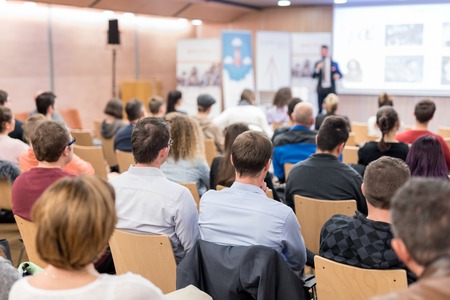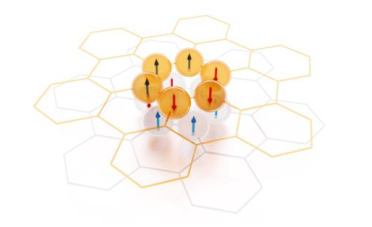
Dr. Svetlana Korneychuk (Karlsruhe Institute of Technology, Institute of Nanotechnology, Germany)
Résumé :
Hydrogen is one of the new energy sources which can take up a leading role in the transfer to the green economy. In this seminar I will demonstrate the application of in-situ TEM to the two major topics in the field of hydrogen technology.
In the first part, I will speak about solid oxide cells which play a key role in the energy transition. They use the chemical energy of the fuel, for instance, hydrogen to produce electricity in a clean way generating only heat and water in the process. Increasing the durability of solid oxide fuel cells is one of the main goals for achieving wider industrial application. The quality of the electrode plays a major role in the performance and durability of a fuel cell. Upon exposure to hydrogen and heat inside in-situ TEM, the reduction mechanism of NiO, a part of NiO/YSZ template for a fuel electrode, can be studied. Using in situ TEM atmosphere system from Protochips the electrode reduction at the H2 pressures up to 1 atmosphere and temperatures up to 850 °C are analyzed. In-situ results go in a good agreement with ex situ results obtained from a bulk cell reduced in a test bench.
Secondly, I am going to address the mechanism of the hydrogen absorption in the nanoscale systems on the example of Pd nanoparticles. Compared to bulk, nanoscale systems interact with hydrogen faster making them more attractive for hydrogen storage, hydrogen detection and catalysis. However, they reveal significant thermodynamic deviations from the bulk due to higher surface to volume ratio, absence of grain boundaries and mechanical stress. Pd is ideal model system to study hydrogen delivery in metals due to its high affinity to hydrogen. In this part I will show the behavior of Pd nanoparticles, in real time with in-situ H2-gas loading in TEM. Initial stages of hydrogen absorption in Pd nanoparticles, local formation of PdHx at different temperatures and pressures can be analyzed by measuring the shift of Pd bulk plasmon with STEM-EELS during in-situ hydrogen loading and unloading in TEM.
Contact : Florian Banhart (florian.banhart@ipcms.unistra.fr)

Anna GALLER / Institute of Theoretical and Computational Physics, Graz University of Technology, Austria
Résumé : Optical phenomena in solids are fascinating and of great importance for technological applications. In this talk, I will first present a novel approach to compute the optical response and color of new inorganic pigment materials from first principles. I will show that the brilliant colors of my target materials, certain transition-metal oxides and rare-earth semiconductors, are strongly influenced by the presence of transition-metal and rare-earth electronic states, whose theoretical treatment requires elaborate many-body techniques.
The second part of the seminar will be focused on nonlinear optical phenomena. I will investigate the response of monolayer hexagonal boron nitride, a prototypical 2D semiconductor, to intense ultrafast laser pulses. I will show that the conduction band charge occupation induced by an elliptically polarized laser can be understood in a multi-photon resonant picture, but remarkably, only if using the Floquet light-dressed states instead of the undressed matter states.
[1] Ransmayr, Tomczak and Galler, PRM 6, 105003 (2022)
[2] Galler, Rubio and Neufeld, J. Phys. Chem. Lett. 14, 50, 11298–11304 (2023)
Pour tout contact : Mébarek ALOUANI : mebarek.alouani@ipcms.unistra.fr

Maxime Durelle (University of Leeds, UK)
Crystallisation in solution is a very common natural and industrial process, but is still poorly understood. Many different processes such as biomineralisation or industrial precipitation imply a nucleation step, but recent literature has shown that non-crystalline transient states often form prior to crystallization., These transient states are, by construction, overlooked by classical nucleation theory, but their direct influence on the nucleation mechanism is still highly debated.5
In this work we propose to investigate how the transient state, which is often small both in size and lifetime, can have a control on the nucleation mechanism. In this regard, we will study two systems, namely the cerium oxalate and the calcium carbonate, which are known to be formed by transient species. This work will aim to confirm or refute three hypotheses: (i) the chemical conditions in the precursor solution do not only affect the composition of the transient state, but also it’s local and long-range structure, (ii) crystallisation kinetics, and even the mechanism, are determined by the structure of the transient state and (iii) the structure of the transient species will alter the nucleation mechanism.
Here we show that (i) concentration and additives change not only the composition but also the structure of the transient species formed prior to the nucleation step, (ii) that the nucleation rate and the dependence of the nucleation rate on supersaturation change drastically with the structure of the transient state, and (iii) that a liquid-like or a solid-like structure of the transient species seems to induce two different nucleation mechanisms.

Voir Événement
With the current urgency for green and renewable energies, photovoltaic (PV) technologies seem to be a partially good candidate for this transition. In the scope of the unending battle in improving photovoltaic efficiencies a better understanding of the photophysical processes in PV materials can lead to better device engineering. In collaboration with the LPI (Laboratory of Photonics and Interfaces, EPFL) I conducted a study of the charge carrier dynamics in 2D hybrid perovskites using different spectroscopic techniques such as femtosecond transient absorption and pump probe terahertz spectroscopy to understand the effect of increasing the size of the spacer within these types of samples. These samples show the characteristic signal of a short lived photoinduced stark effect which was assigned to a charge transfer exciton1. To conclude my talk, I will shortly introduce my thesis project. The subject is the use of Thermally Assisted Delayed Fluorescence (TADF) molecules to overcome the roll-off in organic continuous wave lasers.
- « The Impact of Spacer Size on Charge Transfer Excitons in Dion–Jacobson and Ruddlesden–Popper Layered Hybrid Perovskite » George C. Fish, Aaron T. Terpstra, Algirdas Dučinskas, Masaud Almalki, Loï C. Carbone, Lukas Pfeifer, Michael Grätzel, Jacques-E. Moser, and Jovana V. Milić. The Journal of Physical Chemistry Letters 2023 14 (27), 6248-6254
Contact: Loic Mager <mager@ipcms.unistra.fr>

Orateur : Simon Lenne (Magnetism and spintronics group, CRANN, Trinity College Dublin, Dublin, Ireland)
Résumé : There is growing interest in discovering new materials with strong spin-orbit torque (SOT), leading to the study of a wider range of magnetic materials. The harmonic Hall method is a commonly used technique for SOT measurement. However, this method is unable to distinguish between the Nernst effect and SOT. To address this, I developed an extension of the harmonic Hall method which allows for the accurate separation of Nernst and SOT effects. By simultaneously recording and analysing both the longitudinal and transverse signals, this method enables clear and precise separation of the SOT and the anomalous Nernst signals. Furthermore, the numerical implementation of this method enables the study of samples with a more complex anisotropy, such as Mn2RuGa. This approach allows for efficient measurement of SOT, even when signals are small or dominated by the Nernst effect. As a result, a greater diversity of potential materials can be analysed with accuracy.
Contact: Jean Besbas: jean.besbas@ipcms.unistra.fr

Orateur : Dr. Thijs Stuyver (Chimie ParisTech, PSL)
Résumé :
Machine learning (ML) has had a significant impact on various subfields of science in recent years. Part of the reason for the success of ML is that it enables the generation of predictive models with only limited domain knowledge: usually, only minor modifications to a generic ML algorithm needs to be made to generate effective models for a specific application. That is of course under the condition that sufficient data is available, and then we usually mean hundreds of thousands or even millions of datapoints. In chemistry, there are several predictive tasks for which we have this abundancy of data, but for most specialized applications – particularly those related to chemical reactivity – we do not have this luxury.
In principle, computational chemistry offers a way out when limited experimental data is available, since it enables data generation in a cheap and easy-to-automate manner. In the first part of my talk, I will explore this approach in a bit more detail and focus specifically on an ML accelerated computational workflow to screen for promising bioorthogonal click reactions that I recently developed.
While quantum chemical simulations of reactivity tend to be relatively cheap compared to experimental characterizations, the cost of generating sufficient training data for a machine learning model still becomes prohibitive, fast. As such, in the second part of my talk I will discuss strategies to improve the data efficiency of ML-based computational workflows for reactivity prediction. Specifically, I will focus on models based on intermediate valence bond inspired representations, and demonstrate that these outperform conventional machine learning models by a wide margin for hydrogen atom transfer reactions in the low data regime.
References
- Casetti, N.; Alfonso-Ramos, J. E.; Coley, C. W.*; Stuyver, T.*, Combining Molecular Modeling and Machine learning for accelerated reaction screening and discovery, Chem. Eur. J. 2023, e202301957.
- Stuyver, T.*; Jorner, K.; Coley, C. W.*, Reaction profiles for quantum chemistry-computed [3+2] cycloaddition reactions, Sci. Data 2023, 10, 66.
- Stuyver, T.*; Coley, C. W.*, Machine learning‐guided computational screening of new candidate reactions with high bioorthogonal click potential, Chem. Eur. J. 2023, e202300387.
- Alfonso-Ramos, J.; Neeser, R.; Stuyver, T. Repurposing Quantum Chemical Descriptor Datasets for on-the-Fly Generation of Informative Reaction Representations: Application to Hydrogen Atom Transfer Reactions, ChemRxiv 2023, 10.26434/chemrxiv-2023-2n281.

Florence GAZEAU (MSC Med Lab and IVETh integrator , 45 rue des Saints Pères, 75006 Paris, France)
Résumé : The clinical use of extracellular vesicles (EVs) will progressively become a reality in view of the number of ongoing clinical trials worldwide harnessing EV potency for tissue healing, resolution of inflammation (notably in Covid 19 patients), vaccination, drug delivery or cancer therapies, among others. EVs, encompassing a variety of cell shed nanoscale membrane vesicles (exosomes, ectosomes, microvesicles, OMV from bacteria…), are released by all cell types, either spontaneously or after induction, and circulate in all body fluids playing an active role in many physio- and pathological processes. EVs contribute to intercellular communication and immunomodulation via delivering bio-molecules like nucleic acids, proteins, and lipids that modify the recipient cells. Numerous biological effects of cell therapy rely on the cells’ secretome and, in particular on biomolecules contained in EVs, which are now studied as potential therapeutic agents to recapitulate a substantial part of the parental cell’s benefits, especially for stem cell-derived EVs. However the clinical translation of EV-based biotherapies face numerous challenges such as cost-effective large scale bioproduction compatible with a clinical use (GMP manufacturing), reproducibility from one batch to another and difficulties to isolate, characterize and identify the most potent nanosized subfractions from a complex and heterogeneous cell secretome. In addition, the technologies to engineer EVs in a pre-production or post-production step to convey specific proteins, nucleic acids, drugs and nanoparticles and improve or control their specific targeting and therapeutic activities are still in their infancy. In this presentation, we will present the breakthrough technologies for high throughput bioproduction, engineering and multimodal IA-assisted characterization of therapeutic stem cell-derived EVs, as well as EV delivery, that have been developed in our lab and led to the creation of two spin off. These technologies, based on multidisciplinary and physics-powered approaches (turbulence approach for high yield high throughput EV bioproduction and loading, EV delivery in a carrier gel, multimodal analysis tool box) are available for the industrial and academic partners on our innovation hub IVETh (https://iveth.u-paris.fr/) labelized as a national industrial integrator biotherapy-bioproduction in 2022

Orateur : Vikram Deshpande, University of Utah, USA
Résumé : Topological materials have burgeoned of late due to their implications for the fields of electronics, spintronics and quantum computing, among others. While their electronic properties are important in their own right, they can also couple in fascinating ways to the lattice. We have developed techniques to deform materials controllably and study their resulting electronic properties in-situ, while complementarily sensing the electronic ground state through the mechanical degree of freedom. In this talk, by way of introduction, I will first present purely electrical measurements on the prototypical topological material, the three-dimensional (3D) topological insulator (TI), wherein we hybridize Dirac cones of 3D TI surfaces controllably to realize the quantum spin Hall effect in the ultrathin limit. Then I will present our recent results applying the above-mentioned mechanical techniques to two different topological materials, namely twisted bilayer graphene (TBG) and the intrinsic magnetic topological insulator (MTI) MnBi2Te4, respectively. We are able to tune the Hofstadter’s spectrum of non-magic angle TBG and induce magnetism in non-magnetic correlated insulating states of magic-angle TBG using isotropic strain, for example, and detect various magnetic states and measure magnetoelastic couplings in the case of MTIs. Our advances present unique routes to tuning and sensing the parameter space of these exciting materials.
Contact : Stéphane BERCIAUD (berciaud@unistra.fr)

Oratrice : Amélie JUHIN (Institut de Minéralogie, Physique des Matériaux et Cosmochimie (IMPMC). CNRS-Sorbonne Université)
Résumé : X-ray spectroscopies performed at synchrotron light sources, such as X-ray Absorption Spectroscopy and Resonant Inelastic X-ray Scattering are powerful tools to study complex materials, due to their chemical selectivity that allows disentangling the respective contributions of different atomic species. In this talk, I will show how the use of incident polarized x-rays (either linear or circular) can allow a deeper understanding of the electronic structure and reveal emergent properties, with a focus on remarkable magnetic nanomaterials: Single Molecule Magnets, bimagnetic nanoparticles, ferrofluids, ultra-thin nanowires. Moreover, I will illustrate how the combination of these spectroscopies with x-ray microscopy can provide valuable information with nanoscale spatial resolution, exemplified by recent results obtained on magnetotactic organisms.

Orateur : Benjamin Besga, ILM Lyon
Résumé : The aim of stochastic thermodynamics is to study small non-equilibrium systems subject to thermal fluctuations. Some results from this field will be illustrated using experiments carried out on opto-mechanical systems, mainly colloidal particles in an optical trap. Using non-equilibrium statistical physics will see how we can accelerate the natural dynamics of a system, shorten the mean first passage time on a target, or measure the forces acting on a non-equilibrium probe. Finally, we’ll ask how we can interrogate the quantum limit of these results by looking at the opto-mechanical coupling of a self assembled supercrystal of quantum dots in an optical trap.


